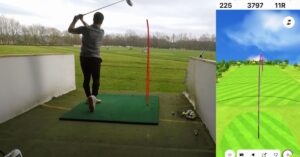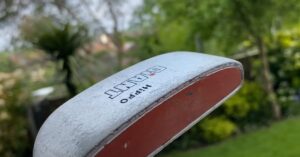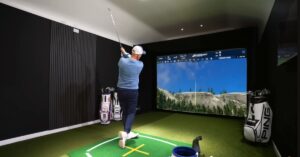Are Used Golf Balls As Good As New? The Great Debate
Golfers of all skill levels are well acquainted with the sense of anticipation that accompanies a fresh box of pristine golf balls.
The smooth surface, the unblemished cover, and the promising potential for long and accurate shots make new golf balls an enticing choice.
But what about used golf balls? Are they a worthy alternative, or are they destined to fall short in terms of performance?
The answer to the question of whether used golf balls are as good as new is a resounding “it depends.” Several factors come into play when evaluating the performance of used golf balls. Balls in better condition are more likely to perform closer to new ones.
In this blog post, we will dive into the great debate surrounding used golf balls and explore whether they can truly stack up against their brand-new counterparts.
Are Used Golf Balls A Viable Alternative To New Ones In Terms Of Performance
Used golf balls can be a viable alternative to new ones in terms of performance, depending on their condition and previous use.
If the used balls are still in good condition and have not been excessively worn or damaged, they can perform similarly to new ones.
However, if the used balls are heavily scuffed or have cuts or cracks, their performance may be compromised.
It’s important to inspect used golf balls carefully before using them to ensure that they are still suitable for play.
What Factors Should Golfers Consider When Determining The Quality Of Used Golf Balls?
When evaluating the quality of used golf balls, golfers should consider several factors to ensure they are making a wise purchase. Here are the key factors to consider:
Brand and Model
Different brands and models of golf balls offer varying performance characteristics. Consider well-known brands and popular models that align with your playing style and preferences.
Ball Condition
Assess the overall condition of the used golf balls. Look for signs of wear, such as scuffs, discoloration, or cuts.
While some cosmetic imperfections may not affect performance significantly, excessive damage can impact the ball’s flight and feel.
Compression Rating
Golf balls have different compression ratings that affect their feel and performance.
Higher compression balls generally suit players with faster swing speeds, while lower compression balls provide more distance and control for slower swing speeds.
Ball Construction
Determine the construction type of the used golf balls. Two-piece balls offer more distance and durability, while multi-layer balls provide enhanced spin and control around the greens. Choose a construction that suits your playing style.
Ball Spin
Consider the spin characteristics of the golf balls. Some players prefer high-spin balls for better control and shot shaping, while others may opt for low-spin balls for a more forgiving and straighter flight.
Ball Grading System
Look for golf balls that have been graded based on their quality. Common grading systems include Mint, Near Mint, AAA, AA, and Practice/Recycled.
Mint or Near Mint balls are in excellent condition, while Practice/Recycled balls may have noticeable wear and tear.
Price
Determine the price range you are comfortable with for used golf balls. Balance the cost with the condition and performance of the balls.
Be cautious of overly cheap options, as they may indicate poor quality or counterfeit products.
Personal Preference and Testing
Every golfer has different preferences and playing styles. If possible, test a few used golf balls before making a bulk purchase. Evaluate their performance in terms of distance, control, and feel to find the right fit for your game.
Seller Reputation
Consider the reputation and reliability of the seller when purchasing used golf balls. Look for trusted sources, such as reputable golf stores, online marketplaces with good ratings, or certified pre-owned golf ball sellers.
Potential Drawbacks Or Limitations Of Using Used Golf Balls
Using used golf balls can have certain drawbacks or limitations that you should be aware of. Here are some potential considerations:
Reduced Performance
Used golf balls may have experienced wear and tear, affecting their performance. They may lose their original spin, distance, and control capabilities, which can impact your game.
The condition of the ball can vary, and some used balls may have visible scuffs or cuts that further affect their performance.
Inconsistent Quality
When purchasing used golf balls, you may encounter inconsistent quality or unknown histories.
Some balls may be in better condition than others, and it can be challenging to determine their true quality without a thorough inspection.
This inconsistency can result in unpredictable performance from one ball to another.
Limited Durability
Used golf balls have already endured some level of play, making them more prone to damage and potential failure.
Even if they appear to be in good condition, there could be internal damage or weakened materials that compromise their durability. This can lead to premature wear or breakage during your game.
Limited Customization Options
If you prefer using specific ball models or customization options, such as personalized logos or markings, finding them in the used golf ball market may be challenging.
You may have to settle for whatever selection is available, limiting your ability to match your preferences and playing style.
Potential Loss
Golf balls are susceptible to getting lost during play, especially on challenging or unfamiliar courses.
While losing a used ball may be less financially burdensome than losing a brand-new one, it can still impact your game and necessitate carrying additional backup balls.
Psychological Factors
Some golfers may have a psychological attachment to using new golf balls. The perception of using a pristine ball can provide confidence and a sense of control.
Using used balls may impact your mindset, potentially influencing your performance on the course.
9 Tips For Purchasing And Testing Used Golf Balls
When purchasing and testing used golf balls, several tips can help you make the right choices and assess their performance effectively. Here are some tips to consider:
1. Assess the Condition
Examine the used golf balls for signs of wear, such as scuffs, discoloration, or cuts. Avoid balls with excessive damage, as it can affect their performance. Look for balls in good overall condition.
2. Buy from Reliable Sources
Purchase used golf balls from reputable sources like golf stores, online marketplaces with positive reviews, or certified pre-owned golf ball sellers.
Trusted sellers are more likely to provide accurate descriptions and quality products.
3. Check Grading and Quality
If the golf balls are graded, pay attention to the grading system used by the seller. Understand the criteria for each grade (e.g., Mint, Near Mint, AAA, AA) to ensure you’re getting the quality you desire.
4. Stick with Well-Known Brands
Consider opting for used golf balls from well-known brands. Established brands often have consistent quality and performance standards. Research popular models from these brands to find ones that suit your game.
5. Buy in Bulk
Purchasing used golf balls in bulk can be more cost-effective. Look for bulk packages or deals that offer a larger quantity at a better price per ball.
This allows for more practice or plays without worrying about running out of balls.
6. Test a Variety of Brands and Models
Experiment with different brands and models of used golf balls to find the ones that match your playing style.
Purchase a small number of various options and test them during practice rounds or on the driving range to assess their performance.
7. Track Performance and Feel
Keep track of how each used golf ball performs in terms of distance, accuracy, spin, and feel.
Note any differences you observe between brands or models. This helps you identify the balls that consistently perform well for you.
8. Compare Against New Balls
Occasionally compare the performance of used golf balls against new ones to see if there are noticeable differences.
This can give you an idea of how the used balls are holding up and if they still meet your expectations.
9. Trust Your Feel and Confidence
Ultimately, go with the used golf balls that feel comfortable and give you confidence in your shots. Golf is a mental game, and having trust in your equipment can positively impact your performance.
Frequently Asked Questions
Welcome to our FAQ section on used golf balls! If you’re curious about using pre-owned golf balls, we’ve got you covered. Explore the answers to common questions to make informed decisions on your golf ball choices.
Do Used Golf Balls Affect Distance And Accuracy?
The impact on distance and accuracy can vary. Minor scuffs or wear may not have a significant effect, but deep cuts or damage can impact both. Testing different used balls can help determine their performance.
Can I Save Money By Using Used Golf Balls?
Absolutely. Used golf balls are often more affordable than new ones. If you’re not overly concerned about minor cosmetic blemishes, purchasing used balls can provide substantial savings without sacrificing performance in most cases.
How Can I Determine The Quality Of Used Golf Balls Before Purchasing?
Look for sellers who provide grading systems, such as AAA, AA, or A, to assess the condition of the used balls. This helps you choose based on your preferences and expected performance.
Can Used Golf Balls Be Refurbished Or Reconditioned?
Some companies offer refurbishing or reconditioning services for used golf balls. These processes involve cleaning, repainting, and sometimes re-covering the balls to restore their appearance and performance.
Conclusion
The performance of used golf balls compared to new ones depends on factors such as condition, ball type, compression, and price.
While they may not match the consistency of new balls, used golf balls can still be a cost-effective option for casual play and practice sessions.
Ultimately, it’s a personal choice based on budget and performance preferences.






